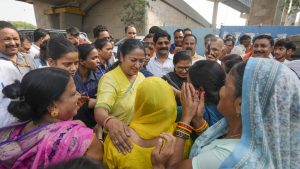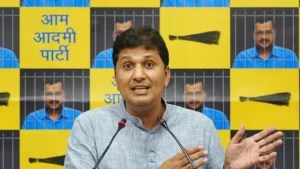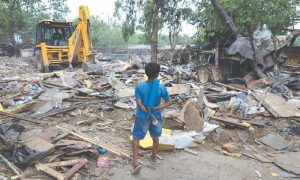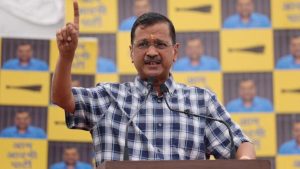New Delhi – The ongoing controversy surrounding Slums Demolition In Delhi has intensified as the Aam Aadmi Party launches a comprehensive campaign against what they term systematic displacement of vulnerable populations. The political battle over housing rights has reached a crescendo with AAP announcing a city-wide mass movement scheduled to commence on June 29 at Jantar Mantar, directly challenging the current administration’s approach to urban development.

The Slums Demolition In Delhi issue has become a flashpoint between AAP and BJP, with thousands of residents facing displacement across multiple locations. The controversy centers around the government’s implementation of demolition orders, which AAP leaders claim violates pre-election promises made to Delhi’s most vulnerable communities.
Chief Minister Defends Actions Citing Court Mandates


Delhi Chief Minister Rekha Gupta has defended the Slums Demolition In Delhi operations by emphasizing their legal foundation. Speaking to media representatives, Gupta categorically stated that all demolition activities were conducted in compliance with judicial directives, particularly highlighting the Madrasi Camp case where courts repeatedly ordered encroachment removal.
The Chief Minister’s justification for Slums Demolition In Delhi centered on the Barapullah drain cleaning project, where courts issued directions four separate times for encroachment removal. Gupta emphasized that neither the government nor administrative authorities possess discretionary power to ignore judicial orders, regardless of the humanitarian implications involved.
According to official statements, the Slums Demolition In Delhi at Madrasi Camp was specifically mandated to enable machinery deployment for drain cleaning operations. The Chief Minister assured that alternative housing arrangements were provided to affected residents, though the adequacy and accessibility of such accommodations remain subjects of ongoing debate.
Also Read About Delhi High Court On Encroachers: Latest Ruling Denies Right On Public Land
Political Accusations and Electoral Implications
AAP leaders have launched sharp criticism against the BJP government’s handling of Slums Demolition In Delhi, particularly focusing on alleged betrayal of electoral promises. The party specifically references the ‘Jahan Jhuggi, Wahan Makan’ commitment, which they claim has been abandoned in favor of displacement policies affecting thousands of migrant families.
The political dimensions of Slums Demolition In Delhi have become particularly pronounced given the timing of these operations. AAP leaders point out that many affected residents are migrants from Bihar, a state currently experiencing electoral activities, suggesting potential political motivations behind the demolition drives.
Delhi convenor Saurabh Bharadwaj’s statements regarding Slums Demolition In Delhi highlight this political tension, alleging that the BJP seeks electoral support in Bihar while simultaneously displacing Bihari migrants in Delhi. This contradiction, according to AAP leadership, exposes the hypocrisy of current housing policies.


Ground Reality at Affected Settlements


The human impact of Slums Demolition In Delhi becomes starkly apparent through resident testimonies and site visits by political leaders. At Madrasi Camp, families who built lives over decades now sit among rubble that once constituted their homes, representing the immediate consequences of urban development policies.
The Slums Demolition In Delhi at Model Town’s Azadpur area presents another complex scenario, where two parallel settlements exist on either side of railway tracks. Northern Railways executed demolitions on one side for operational safety and signal visibility, while residents on the opposite side live in constant fear of impending displacement.
Sampat, a long-time Azadpur camp resident, articulates the psychological impact of Slums Demolition In Delhi policies. His testimony reveals that residents received vacation notices before elections, but AAP protests temporarily halted the demolitions. However, the community now anticipates inevitable displacement, creating an atmosphere of uncertainty and fear.
Historical Context and Community Impact
The Slums Demolition In Delhi controversy gains additional complexity when considering the historical establishment of these communities. Madrasi Camp, for instance, housed families who migrated from Tamil Nadu fifty years ago, establishing deep roots and contributing to Delhi’s economic and social fabric over multiple generations.


AAP MP Sanjay Singh’s observations about Slums Demolition In Delhi emphasize the emotional and financial devastation experienced by affected families. His social media statements highlight the irony of destroying homes that families spent lifetimes building, while questioning the humanitarian sensitivity of current policies.
The demographic composition of areas affected by Slums Demolition In Delhi reveals a pattern of migrant vulnerability. Residents primarily work in essential service sectors, including domestic help, factory labor, and local commerce, representing Delhi’s economic backbone despite their precarious housing situations.
Legal Framework and Administrative Challenges
The Slums Demolition In Delhi operations occur within complex legal frameworks involving multiple authorities and jurisdictions. The Madrasi Camp case exemplifies this complexity, where environmental concerns about waterlogging and drain maintenance intersect with housing rights and rehabilitation obligations.
Railway-related Slums Demolition In Delhi at Model Town highlights additional jurisdictional challenges, where operational safety requirements conflict with community housing needs. Northern Railways’ emphasis on signal visibility and safety protocols demonstrates how infrastructure demands often supersede humanitarian considerations in urban planning decisions.


The legal precedents established through Slums Demolition In Delhi cases will likely influence future settlement policies and rehabilitation frameworks. Courts’ repeated orders for encroachment removal suggest judicial priority for infrastructure functionality over incremental housing rights recognition.
Planned Resistance and Future Implications


The AAP’s announcement of mass movement against Slums Demolition In Delhi represents a significant escalation in political resistance to current policies. The June 29 Jantar Mantar gathering aims to mobilize city-wide opposition to what the party characterizes as systematic displacement of vulnerable populations.
This organized response to Slums Demolition In Delhi policies may establish precedents for community resistance and political mobilization around housing rights issues. The success or failure of such movements could influence future government approaches to settlement policies and rehabilitation programs.

The broader implications of Slums Demolition In Delhi extend beyond immediate housing concerns to encompass questions of urban planning philosophy, migrant rights, and political accountability. The outcome of current controversies will likely shape Delhi’s approach to informal settlements for years to come.
Closing Statements
The ongoing debate surrounding Slums Demolition In Delhi reflects fundamental tensions between development imperatives and housing rights, legal compliance and humanitarian concerns, and political promises versus administrative realities. As the June 29 mass movement approaches, the resolution of these conflicts will determine both immediate community welfare and long-term urban development trajectories in the national capital.

